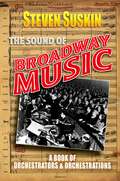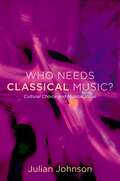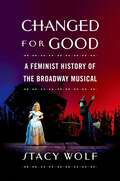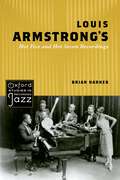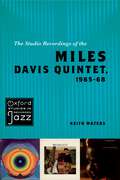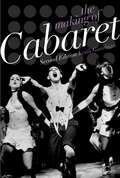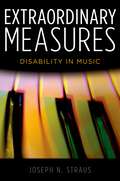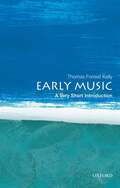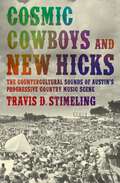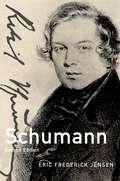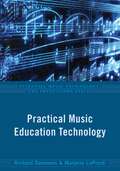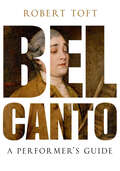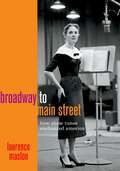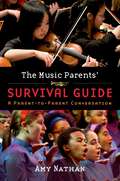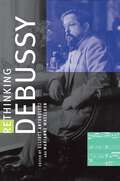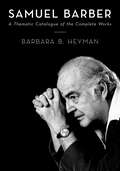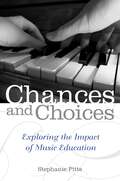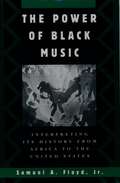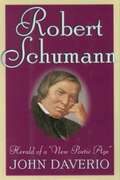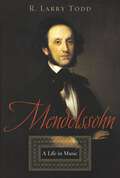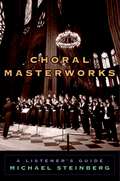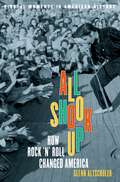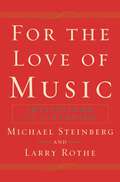- Table View
- List View
The Sound of Broadway Music: A Book of Orchestrators and Orchestrations
by Steven SuskinBroadway's top orchestrators - Robert Russell Bennett, Don Walker, Philip J. Lang, Jonathan Tunick - are names well known to musical theatre fans, but few people understand precisely what the orchestrator does. The Sound of Broadway Music is the first book ever written about these unsung stars of the Broadway musical whose work is so vital to each show's success. The book examines the careers of Broadway's major orchestrators and follows the song as it travels from the composer's piano to the orchestra pit. Steven Suskin has meticulously tracked down thousands of original orchestral scores, piecing together enigmatic notes and notations with long-forgotten documents and current interviews with dozens of composers, producers, conductors and arrangers. The information is separated into three main parts: a biographical section which gives a sense of the life and world of twelve major theatre orchestrators, as well as incorporating briefer sections on another thirty arrangers and conductors; a lively discussion of the art of orchestration, written for musical theatre enthusiasts (including those who do not read music); a biographical section which gives a sense of the life and world of twelve major theatre orchestrators, as well as incorporating briefer sections on another thirty arrangers and conductors; and an impressive show-by-show listing of more than seven hundred musicals, in many cases including a song-by-song listing of precisely who orchestrated what along with relevant comments from people involved with the productions. Stocked with intriguing facts and juicy anecdotes, many of which have never before appeared in print, The Sound of Broadway Music brings fascinating and often surprising new insight into the world of musical theatre.
Who Needs Classical Music?: Cultural Choice and Musical Value
by Julian JohnsonDuring the last few decades, most cultural critics have come to agree that the division between "high" and "low" art is an artificial one, that Beethoven's Ninth and "Blue Suede Shoes" are equally valuable as cultural texts. In Who Needs Classical Music?, Julian Johnson challenges these assumptions about the relativism of cultural judgements. The author maintains that music is more than just "a matter of taste": while some music provides entertainment, or serves as background noise, other music claims to function as art. This book considers the value of classical music in contemporary society, arguing that it remains distinctive because it works in quite different ways to most of the other music that surrounds us. This intellectually sophisticated yet accessible book offers a new and balanced defense of the specific values of classical music in contemporary culture. Who Needs Classical Music? will stimulate readers to reflect on their own investment (or lack of it) in music and art of all kinds.
Changed for Good: A Feminist History of the Broadway Musical
by Stacy WolfFrom Adelaide in "Guys and Dolls" to Nina in "In the Heights" and Elphaba in "Wicked," female characters in Broadway musicals have belted and crooned their way into the American psyche. In this lively book, Stacy Wolf illuminates the women of American musical theatre - performers, creators, and characters -- from the start of the cold war to the present day, creating a new, feminist history of the genre. Moving from decade to decade, Wolf first highlights the assumptions that circulated about gender and sexuality at the time. She then looks at the leading musicals to stress the key aspects of the plays as they relate to women, and often finds overlooked moments of empowerment for female audience members. The musicals discussed here are among the most beloved in the canon--"West Side Story," "Cabaret," "A Chorus Line," "Phantom of the Opera," and many others--with special emphasis on the blockbuster "Wicked." Along the way, Wolf demonstrates how the musical since the mid-1940s has actually been dominated by women--women onstage, women in the wings, and women offstage as spectators and fans.
Louis Armstrong's Hot Five and Hot Seven Recordings (Oxford Studies in Recorded Jazz)
by Brian HarkerFor jazz historians, Louis Armstrong's Hot Five and Hot Seven recordings mark the first revolution in the history of a music riven by upheaval. Yet few traces of this revolution can be found in the historical record of the late 1920s, when the discs were made. Even black newspapers covered Armstrong as just one name among many, and descriptions of his playing, while laudatory, bear little resemblance to those of today. Through a careful analysis of seven seminal recordings in this compact and engaging book, author Brian Harker recaptures the perspective of Armstrong's original audience without abandoning that of today's listeners. The world of vaudeville and show business provide crucial context to his readings, revealing how the demands of making a living in a competitive environment catalyzed Armstrong's unique artistic gifts. Invoking a breadth of influences ranging from New Orleans clarinet style to Guy Lombardo, and from tap dancing to classical music, Louis Armstrong's Hot Five and Hot Seven Recordings offers bold insights, fresh anecdotes, and, ultimately, a new interpretation of Louis Armstrong and his most influential body of work.
The Studio Recordings of the Miles Davis Quintet, 1965-68 (Oxford Studies in Recorded Jazz)
by Keith WatersThe "Second Quintet" -- the Miles Davis Quintet of the mid-1960s -- was one of the most innovative and influential groups in the history of the genre. Each of the musicians who performed with Davis--saxophonist Wayne Shorter, pianist Herbie Hancock, bassist Ron Carter, and drummer Tony Williams--went on to a successful career as a top player. The studio recordings released by this group made profound contributions to improvisational strategies, jazz composition, and mediation between mainstream and avant-garde jazz, yet most critical attention has focused instead on live performances or the socio-cultural context of the work. Keith Waters' The Studio Recordings of the Miles Davis Quintet, 1965-68 concentrates instead on the music itself, as written, performed, and recorded. Treating six different studio recordings in depth--ESP, Miles Smiles, Sorcerer, Nefertiti, Miles in the Sky, and Filles de Kilimanjaro--Waters has tracked down a host of references to and explications of Davis' work. His analysis takes into account contemporary reviews of the recordings, interviews with the five musicians, and relevant larger-scale cultural studies of the era, as well as two previously unexplored sources: the studio outtakes and Wayne Shorter's Library of Congress composition deposits. Only recently made available, the outtakes throw the master takes into relief, revealing how the musicians and producer organized and edited the material to craft a unified artistic statement for each of these albums. The author's research into the Shorter archives proves to be of even broader significance and interest, as Waters is able now to demonstrate the composer's original conception of a given piece. Waters also points out errors in the notated versions of the canonical songs as they often appear in the main sources available to musicians and scholars. An indispensible resource, The Miles Davis Quintet Studio Recordings: 1965-1968 is suited for the jazz scholar as well as for jazz musicians and aficionados of all levels.
The Making of Cabaret
by Keith GarebianA handy and engaging chronicle, this book is the most detailed production history to date of the original Broadway version of Cabaret, showing how the show evolved from Christopher Isherwood's Berlin stories, into John van Druten's stage play, a British film adaptation, and then the Broadway musical, conceived and directed by Harold Prince as an early concept musical. With nearly 40 illustrations, full cast credits, and a bibliography, The Making of Cabaret will appeal to musical theatre aficionados, theatre specialists, and students and performers of musical theatre.
Extraordinary Measures: Disability in Music
by Joseph N. StrausApproaching disability as a cultural construction rather than a medical pathology, this book studies the impact of disability and concepts of disability on composers, performers, and listeners with disabilities, as well as on discourse about music and works of music themselves. For composers with disabilities--like Beethoven, Delius, and Schumann--awareness of the disability sharply inflects critical reception. For performers with disabilities--such as Itzhak Perlman and Evelyn Glennie--the performance of disability and the performance of music are deeply intertwined. For listeners with disabilities, extraordinary bodies and minds may give rise to new ways of making sense of music. In the stories that people tell about music, and in the stories that music itself tells, disability has long played a central but unrecognized role. Some of these stories are narratives of overcoming-the triumph of the human spirit over adversity-but others are more nuanced tales of accommodation and acceptance of life with a non-normative body or mind. In all of these ways, music both reflects and constructs disability.
Early Music: A Very Short Introduction (Very Short Introductions)
by Thomas Forrest KellyFrom Gregorian chant to Bach's Brandenburg Concerti, the music of the Medieval, Renaissance, and Baroque periods is both beautiful and intriguing, expanding our horizons as it nourishes our souls. In this Very Short Introduction, Thomas Forrest Kelly provides not only a compact overview of the music itself, but also a lively look at the many attempts over the last two centuries to revive it. Kelly shows that the early-music revival has long been grounded in the idea of spontaneity, of excitement, and of recapturing experiences otherwise lost to us--either the rediscovery of little-known repertories or the recovery of lost performing styles, with the conviction that, with the right performance, the music will come to life anew. Blending musical and social history, he shows how the Early Music movement in the 1960s took on political overtones, fueled by a rebellion against received wisdom and enforced conformity. Kelly also discusses ongoing debates about authenticity, the desirability of period instruments, and the relationship of mainstream opera companies and symphony orchestras to music that they often ignore, or play in modern fashion.
Cosmic Cowboys and New Hicks: The Countercultural Sounds of Austin's Progressive Country Music Scene
by Travis D. StimelingCountry music of late 1960s and early 1970s was a powerful symbol of staunch conservative resistance to the flowering hippie counterculture. But in 1972, the city of Austin, Texas became host to a growing community of musicians, entrepreneurs, journalists, and fans who saw country music as a part of their collective heritage and sought to reclaim it for their own progressive scene. These children of the Cold War, post-World War II suburban migration, and the Baby Boom escaped the socially conservative world their parents had created, to instead create for themselves an idyllic rural Texan utopia. Progressive country music--a hybrid of country music and rock--played out the contradictions at work among the residents of the growing Austin community: at once firmly grounded in the conservative Texan culture in which they had been raised and profoundly affected by the current hippie counterculture. In Cosmic Cowboys and New Hicks: The Countercultural Sounds of Austin's Progressive Country Music Scene, Travis Stimeling connects the local Austin culture and the progressive music that became its trademark. He presents a colorful range of evidence, from behavior and dress, to newspaper articles, to personal interviews of musicians as diverse as Willie Nelson, Jerry Jeff Walker, and Doug Sahm. Along the way, Stimeling uncovers parodies of the cosmic cowboy image that reinforce the longing for a more peaceful way of life, but that also recognize an awareness of the muddled, conflicted nature of this counterculture identity. Cosmic Cowboys and New Hicks brings new insight into the inner workings of Austin's progressive country music scene -- by bringing the music and musicians brilliantly to life. This book will appeal to students and scholars of popular music studies, musicology and ethnomusicology, sociology, cultural studies, folklore, American studies, and cultural geography; the lucid prose and interviews will also make the book attractive to fans of the genre and artists discussed within. Austin residents past and present, as well as anyone with an interest in the development of progressive music or today's 'alt.country' movement will find Cosmic Cowboys and New Hicks an informative, engaging resource.
Schumann (Master Musicians Series)
by Eric Frederick JensenRobert Schumann is one of the most intriguing-and enigmatic-composers of the nineteenth century. Extraordinarily gifted in both music and literature, many of his compositions were inspired by poetry and novels. For much of his life he was better known as a music critic than as a composer. But whether writing as critic or composer, what he produced was created by him as a reflection of his often turbulent life. Best known was the tempestuous courtship of his future wife, the pianist Clara Wieck. Though marriage and family life seemed to provide a sense of constancy, he increasingly experienced periods of depression and instability. Mounting criticism of his performance as music director at Dusseldorf led to his attempted suicide in 1854. Schumann was voluntarily committed to an insane asylum near Bonn where, despite indications of improvement and dissatisfaction with his treatment, he spent the final two years of his life. Drawing on original research and newly published letters and journals from the time, author Eric Frederick Jensen presents a balanced portrait of the composer with both scholarly authority and engaging clarity. Biographical chapters alternate with discussion of Schumann's piano, chamber, choral, symphonic, and operatic works, demonstrating how the circumstances of his life helped shape the music he wrote. Chronicling the romance of Robert and Clara, Jensen offers a nuanced look at the evolution of their relationship, one that changed dramatically after marriage. He also follows Schumann's creative musical criticism, which championed the burgeoning careers of Chopin, Liszt, and Brahms and challenged the musical tastes of Europe.
Practical Music Education Technology (Essential Music Technology:The Prestissimo Series)
by Richard Dammers Marjorie LoPrestiToday's music teachers are caught in a conundrum about technology - while all are interested in it and told to utilize it in music instruction, a lack of equipment and funding act as enormous barriers to technology access. In fact, studies indicate that the mere perception of these obstacles may be partly responsible for the gap between these teachers' interest in technology and the lack of technology integration in the classroom. As a result, students potentially miss out on active, hands-on music technology instruction at school. In Practical Music Education Technology, veteran music educators Rick Dammers and Marjorie LoPresti help music teachers introduce technology into the classroom by providing accessible strategies to support and enrich students' musical learning. The authors highlight a plethora of free online tools at teachers' disposal, and provide options that can be flexible for all school environments and types of teachers - from those with large budgets to those operating on a shoestring, from those well-versed in technology to non-experts. Each chapter outlines pedagogically appropriate resources and strategies that facilitate, support, and enhance music learning, performance, and creation. Additionally, model lesson plans featuring classroom-tested uses of technology aim to empower student engagement while also keeping music learning goals at the forefront. All teaching ideas presented can be tailored to individual teachers' needs and preferences, making Practical Music Education Technology an essential guide to music technology for the everyday music teacher.
Bel Canto: A Performer's Guide
by Robert ToftBel canto, or 'beautiful singing,' remains one of the most elusive performance styles vocalists strive to master. During the eighteenth and early nineteenth centuries, composers routinely left the final shaping of recitatives, arias, and songs to performers, and singers treated scores freely so that inexpressively notated music could be turned into passionate declamation. In other words, vocalists saw their role more as one of re-creation than of simple interpretation. Familiarity with the range of strategies prominent singers of the past employed to unlock the eloquent expression hidden in scores enables modern performers to take a similar re-creative approach to enhancing the texts before them. In this first ever guide to bel canto, author Robert Toft provides singers with the tools they need not only to complete the creative process the composer began but also to bring scores to life in an historically-informed manner. Replete with illustrations based on excerpts from Italianate recitatives and arias by composers ranging from Handel to Rossini, the book offers discussions of the fundamental principles of expressive singing, each section including a practical application of the techniques involved. Drawing on a wealth of documents from the era, including treatises, scores, newspaper reviews, and letters, this book captures the breadth of practices singers used in the bel canto period. Complete with six scores (recitatives and/or arias) for performers to personalize through the old methods, and a companion website offering demonstrations of the principles involved, Bel Canto is an essential resource for any singer or vocal instructor wishing to explore and master historical techniques of interpretation and re-creation from the eighteenth and early nineteenth centuries.
Broadway to Main Street: How Show Tunes Enchanted America
by Laurence MaslonThe music of Broadway is one of America's most unique and popular calling cards. In Broadway to Main Street: How Show Tunes Enchanted America, author Laurence Maslon tells the story of how the most beloved songs of the American Musical Theater made their way from the Theater District to living rooms across the country. The crossroads where the music of Broadway meets popular culture is an expansive and pervasive juncture throughout most of the twentieth century--from sheet music to radio broadcasts to popular and original cast recordings--and continues to influence culture today through television, streaming, and the Internet. The original Broadway cast album--from the 78 rpm recording of Oklahoma! to the digital download of Hamilton--is one of the most successful, yet undervalued, genres in the history of popular recording. The challenge of capturing musical narrative with limited technology inspired the imagination of both the recording industry and millions of listeners: between 1949 and 1969, fifteen different original cast albums hit number one on the popular music charts, ultimately tallying more weeks at number one than all of the albums by Frank Sinatra, Elvis Presley, and The Beatles combined. The history of Broadway music is also the history of American popular music; the technological, commercial, and marketing forces of communications and media over the last century were inextricably bound up in the enterprise of bringing the musical gems of New York's Theater District to living rooms along Main Streets across the nation. Featuring new interviews with Stephen Schwartz, Chita Rivera, Steve Lawrence, and prominent record producers and music critics, the story of this commercial and emotional phenomenon is told here in full--from the imprimatur of sheet music from Broadway in the early 20th century to the renaissance of Broadway music in the digital age, folding in the immense impact of show music on American culture and in the context of the recording industry, popular tastes, and our shared national identity. A book which connects cherished cultural artifacts to the emotional narratives at the core of American popular music, Broadway to Main Street: How Show Tunes Enchanted America is an ideal companion for all fans of American musical theater and popular music.
The Music Parents' Survival Guide: A Parent-to-Parent Conversation
by Amy NathanThis book of parent-to-parent advice aims to encourage, support, and bolster the morale of one of music's most important back-up sections: music parents. Within these pages, more than 150 veteran music parents contribute their experiences, reflections, warnings, and helpful suggestions for how to walk the music-parenting tightrope: how to be supportive but not overbearing, and how to encourage excellence without becoming bogged down in frustration. Among those offering advice are the parents of several top musicians, including the mother of violinist Joshua Bell, the father of trumpeter Wynton Marsalis, the parents of cellist Alisa Weilerstein, and those of violinist Anne Akiko Meyers. The book also features advice from music educators and more than forty professional musicians, including Paula Robison, Sarah Chang, Anthony McGill, Jennifer Koh, Jonathan Biss, Toyin Spellman-Diaz, Marin Alsop, Christian McBride, Miguel Zenón, Stephanie Blythe, Lawrence Brownlee, Kelli O'Hara, as well as Joshua Bell, Alisa Weilerstein, Wynton Marsalis, Anne Akiko Meyers, and others. The topics they discuss span a wide range of issues faced by the parents of both instrumentalists and singers, from how to get started and encourage effective practice habits, to how to weather the rough spots, cope with the cost of music training, deal with college and career concerns, and help young musicians discover the role that music can play in their lives. The parents who speak here reach a unanimous and overwhelming conclusion that music parenting is well worth the effort, and the experiences that come with it - from sitting in on early lessons and watching their kids perform onstage to tagging along at music conventions as their youngsters try out instruments at exhibitors' booths - enrich family life with a unique joy in music.
Rethinking Debussy
by Elliott Antokoletz Marianne WheeldonComposer, pianist, and critic Claude Debussy's musical aesthetic represents the single most powerful influence on international musical developments during the long fin de siècle period. The development of Debussy's musical language and style was affected by the international political pressures of his time, beginning with the Franco-Prussian War of 1871 and the rise of the new Republic in France, and was also related to the contemporary philosophical conceptualization of what constituted art. The Debussy idiom exemplifies the ways in which various disciplines - musical, literary, artistic, philosophical, and psychological - can be incorporated into a single, highly-integrated artistic conception. Rethinking Debussy draws together separate areas of Debussy research into a lucid perspective that reveals the full significance of the composer's music and thought in relation to the broader cultural, intellectual, and artistic issues of the twentieth century. Ranging from new biographical information to detailed interpretations of Debussy's music, the volume offers significant multidisciplinary insight into Debussy's music and musical life, as well as the composer's influence on the artistic developments that followed. Chapters include: "Russian Imprints in Debussy's Piano Music"; "Music as Encoder of the Unconscious in Pelléas et Mélisande"; "An Artist High and Low, or Debussy and Money"; "Debussy's Ideal Pelléas and the Limits of Authorial Intent"; "Debussy in Daleville: Toward Early Modernist Hearing in the United States"; and more. Rethinking Debussy will appeal to students and scholars of French music, opera, and modernism, and literary and French studies scholars, particularly concerned with Symbolism and theatre. General readers will be drawn to the book as well, particularly to chapters focusing on Debussy's finances, dramatic works, and reception.
Samuel Barber: A Thematic Catalogue of the Complete Works
by Barbara HeymanSamuel Barber: A Thematic Catalogue of the Complete Works is the first publication to list the entire musical output of Samuel Barber, one of the most beloved and frequently performed American composers. In this exhaustive study, renowned Barber biographer Barbara Heyman chronologically lists and details hundreds of core repertory and the most recently published works, as well as numerous works previously unknown and unpublished. Each entry includes information about first performances, commissions, and the circumstances and inspiration of the composition; the texts of songs; a musical extract containing the opening measures of each work, movement, or major aria; duration, revisions, editions, arrangements, and a select discography of historical and contemporary performances. The descriptions of manuscript sources provide details about the hundreds of holograph manuscripts, sketches, drafts, and significant publisher's proofs with Barber's corrections. Entries are enhanced by Heyman's extensive commentary, which draws from Barber's correspondence, interviews, and diaries. Useful appendices to the catalogue comprise a register of works by genre; an alphabetical directory of works; an index of first lines of vocal works; a listing by nationality of authors and translators of texts set by Barber; and a comprehensive discography. This thematic catalogue is an invaluable guide for musicians, scholars, and students, providing an essential foundation for any serious study of Barber and his music.
Chances and Choices: Exploring the Impact of Music Education
by Stephanie PittsIn Chances and Choices, Stephanie Pitts surveys the aims and impact of formative musical experiences, evaluating the extent to which music education of various kinds provides a foundation for lifelong involvement and interest in music. Pitts draws upon rich qualitative data from her own extensive original study of over 100 adults with an active interest in music in the UK and Italy to address several key themes in the study of music education. Intertwined with discussion of topics such as music education policy and the role that music teachers and other role models play in nurturing musicians are first person 'interludes' that showcase the stories and voices of the research participants as they reflect upon the influences and opportunities that shaped their musical life histories. Pitts' analysis adds valuable context to these stories, illuminating the historical and contemporary debates about music education and proposing ways in which school music might better prepare young people for continued participation in music throughout their lives. A companion website contains Pitts' data sets and analytical frameworks; the website also features an interactive database through which readers can share their own musical life histories and search others that have been contributed there. Shedding new light on the long-term effects of music education, Chances and Choices is an important resource to understand how we can encourage lasting engagement with music and other cultural activities in every individual.
The Power of Black Music: Interpreting Its History from Africa to the United States
by Samuel A. FloydWhen Jimi Hendrix transfixed the crowds of Woodstock with his gripping version of "The Star Spangled Banner," he was building on a foundation reaching back, in part, to the revolutionary guitar playing of Howlin' Wolf and the other great Chicago bluesmen, and to the Delta blues tradition before him. But in its unforgettable introduction, followed by his unaccompanied "talking" guitar passage and inserted calls and responses at key points in the musical narrative, Hendrix's performance of the national anthem also hearkened back to a tradition even older than the blues, a tradition rooted in the rings of dance, drum, and song shared by peoples across Africa. Bold and original, The Power of Black Music offers a new way of listening to the music of black America, and appreciating its profound contribution to all American music. Striving to break down the barriers that remain between high art and low art, it brilliantly illuminates the centuries-old linkage between the music, myths and rituals of Africa and the continuing evolution and enduring vitality of African-American music. Inspired by the pioneering work of Sterling Stuckey and Henry Louis Gates, Jr., author Samuel A. Floyd, Jr, advocates a new critical approach grounded in the forms and traditions of the music itself. He accompanies readers on a fascinating journey from the African ring, through the ring shout's powerful merging of music and dance in the slave culture, to the funeral parade practices of the early new Orleans jazzmen, the bluesmen in the twenties, the beboppers in the forties, and the free jazz, rock, Motown, and concert hall composers of the sixties and beyond. Floyd dismisses the assumption that Africans brought to the United States as slaves took the music of whites in the New World and transformed it through their own performance practices. Instead, he recognizes European influences, while demonstrating how much black music has continued to share with its African counterparts. Floyd maintains that while African Americans may not have direct knowledge of African traditions and myths, they can intuitively recognize links to an authentic African cultural memory. For example, in speaking of his grandfather Omar, who died a slave as a young man, the jazz clarinetist Sidney Bechet said, "Inside him he'd got the memory of all the wrong that's been done to my people. That's what the memory is....When a blues is good, that kind of memory just grows up inside it." Grounding his scholarship and meticulous research in his childhood memories of black folk culture and his own experiences as a musician and listener, Floyd maintains that the memory of Omar and all those who came before and after him remains a driving force in the black music of America, a force with the power to enrich cultures the world over.
Robert Schumann: Herald of a "New Poetic Age"
by John DaverioForced by a hand injury to abandon a career as a pianist, Robert Schumann went on to become one of the world's great composers. Among many works, his Spring Symphony (1841), Piano Concerto in A Minor (1841/1845), and the Third, or Rhenish, Symphony (1850) exemplify his infusion of classical forms with intense, personal emotion. His musical influence continues today and has inspired many other famous composers in the century since his death. Indeed Brahms, in a letter of January 1873, wrote: "The remembrance of Schumann is sacred to me. I will always take this noble pure artist as my model." Now, in Robert Schumann: Herald of a "New Poetic Age," John Daverio presents the first comprehensive study of the composer's life and works to appear in nearly a century. Long regarded as a quintessentially romantic figure, Schumann also has been portrayed as a profoundly tragic one: a composer who began his career as a genius and ended it as a mere talent. Daverio takes issue with this Schumann myth, arguing instead that the composer's entire creative life was guided by the desire to imbue music with the intellectual substance of literature. A close analysis of the interdependence among Schumann's activities as reader, diarist, critic, and musician reveals the depth of his literary sensibility. Drawing on documents only recently brought to light, the author also provides a fresh outlook on the relationship between Schumann's mental illness--which brought on an extended sanitarium stay and eventual death in 1856--and his musical creativity. Schumann's character as man and artist thus emerges in all its complexity. The book concludes with an analysis of the late works and a postlude on Schumann's influence on successors from Brahms to Berg. This well-researched study of Schumann interprets the composer's creative legacy in the context of his life and times, combining nineteenth-century cultural and intellectual history with a fascinating analysis of the works themselves.
Mendelssohn: A Life in Music
by R. Larry ToddAn extraordinary prodigy of Mozartean abilities, Felix Mendelssohn Bartholdy was a distinguished composer and conductor, a legendary pianist and organist, and an accomplished painter and classicist. Lionized in his lifetime, he is best remembered today for several staples of the concert hall and for such popular music as "The Wedding March" and "Hark, the Herald Angels Sing." Now, in the first major Mendelssohn biography to appear in decades, R. Larry Todd offers a remarkably fresh account of this musical giant, based upon painstaking research in autograph manuscripts, correspondence, diaries, and paintings. Rejecting the view of the composer as a craftsman of felicitous but sentimental, saccharine works (termed by one critic "moonlight with sugar water"), Todd reexamines the composer's entire oeuvre, including many unpublished and little known works. Here are engaging analyses of Mendelssohn's distinctive masterpieces--the zestful Octet, puckish Midsummer Night's Dream, haunting Hebrides Overtures, and elegiac Violin Concerto in E minor. Todd describes how the composer excelled in understatement and nuance, in subtle, coloristic orchestrations that lent his scores an undeniable freshness and vividness. He also explores Mendelssohn's changing awareness of his religious heritage, Wagner's virulent anti-Semitic attack on Mendelssohn's music, the composer's complex relationship with his sister Fanny Hensel, herself a child prodigy and prolific composer, his avocation as a painter and draughtsman, and his remarkable, polylingual correspondence with the cultural elite of his time. Mendelssohn: A Life offers a masterful blend of biography and musical analysis. Readers will discover many new facets of the familiar but misunderstood composer and gain new perspectives on one of the most formidable musical geniuses of all time.
Choral Masterworks: A Listener's Guide
by Michael SteinbergMichael Steinberg's highly successful listener's guides--The Symphony and The Concerto--have been universally praised for their blend of captivating biography, crystal clear musical analysis, and delightful humor. Now Steinberg follows these two greatly admired volumes with Choral Masterworks, the only such guide available to this most popular of musical forms. Here are more than fifty illuminating essays on the classic choral masterworks, ranging from Handel's Messiah, Bach's Mass in B Minor, and Beethoven's Missa solemnis, to works by Haydn, Brahms, Mendelssohn, and many others. Steinberg spans the entire history of classical music, from such giants of the Romantic era as Verdi and Berlioz, to leading modern composers such as Elgar, Rachmaninoff, Vaughan Williams, and Stravinsky, to contemporary masters such as John Adams and Charles Wuorinen. For each piece, Steinberg includes a fascinating biographical account of the work's genesis, often spiced with wonderful asides. The author includes an astute musical analysis of each piece, one that casual music lovers can easily appreciate and that more serious fans will find invaluable. The book also provides basic information such as the various movements of the work, the organization of the chorus and orchestra, and brief historical notes on early performances. More than twenty million Americans perform regularly in choirs or choruses. Choral Masterworks will appeal not only to concert goers and CD collectors, but also to this vast multitude of choral performers, an especially engaged and active community. "What sets Steinberg's writing apart is its appealing mixture of impregnable authority (he knows this music) and purely personal asides (by the end of the book, we know this man). Choral Masterworks can be read by anybody, from a professional musician to any young listener newly braced by the stoic pessimism of the Brahms 'German Requiem.'" --Washington Post Book World
All Shook Up: How Rock 'n' Roll Changed America (Pivotal Moments in American History)
by Glenn C. AltschulerThe birth of rock 'n roll ignited a firestorm of controversy--one critic called it "musical riots put to a switchblade beat"--but if it generated much sound and fury, what, if anything, did it signify? As Glenn Altschuler reveals in All Shook Up, the rise of rock 'n roll--and the outraged reception to it--in fact can tell us a lot about the values of the United States in the 1950s, a decade that saw a great struggle for the control of popular culture. Altschuler shows, in particular, how rock's "switchblade beat" opened up wide fissures in American society along the fault-lines of family, sexuality, and race. For instance, the birth of rock coincided with the Civil Rights movement and brought "race music" into many white homes for the first time. Elvis freely credited blacks with originating the music he sang and some of the great early rockers were African American, most notably, Little Richard and Chuck Berry. In addition, rock celebrated romance and sex, rattled the reticent by pushing sexuality into the public arena, and mocked deferred gratification and the obsession with work of men in gray flannel suits. And it delighted in the separate world of the teenager and deepened the divide between the generations, helping teenagers differentiate themselves from others. Altschuler includes vivid biographical sketches of the great rock 'n rollers, including Elvis Presley, Fats Domino, Chuck Berry, Little Richard, Jerry Lee Lewis, and Buddy Holly--plus their white-bread doppelgangers such as Pat Boone. Rock 'n roll seemed to be everywhere during the decade, exhilarating, influential, and an outrage to those Americans intent on wishing away all forms of dissent and conflict. As vibrant as the music itself, All Shook Up reveals how rock 'n roll challenged and changed American culture and laid the foundation for the social upheaval of the sixties.
For The Love of Music: Invitations to Listening
by Michael Steinberg Larry RotheThe power of music, the way it works on the mind and heart, remains an enticing mystery. Now two noted writers on classical music, Michael Steinberg and Larry Rothe, explore the allure of this melodious art--not in the clinical terms of social scientists--but through stories drawn from their own experience. In For the Love of Music, Steinberg and Rothe draw on a lifetime of listening to, living with, and writing about music, sharing the delights and revelatory encounters they have had with Mozart, Brahms, Stravinsky, and a host of other great (and almost-great) composers. At once highly personal and immediately accessible, their writings shed light on those who make music and those who listen to it--drawing readers into the beautiful and dangerous terrain that has meant so much to the authors. In recounting how they themselves came to love music, Steinberg and Rothe offer keys for listening. You will meet the man who created the sound of Hollywood's Golden Age and you will learn how composers have addressed issues as contemporary as AIDS and the terrorist attacks of September 11.
